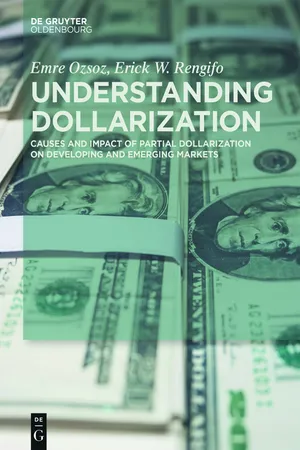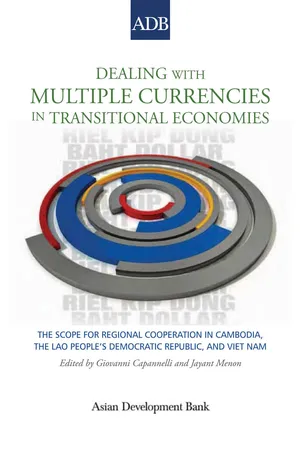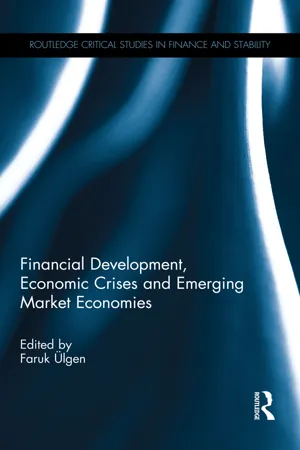Economics
Dollarization
Dollarization refers to the adoption of the US dollar as the official currency in a country, either alongside or instead of the domestic currency. This can occur due to economic instability, hyperinflation, or a lack of confidence in the domestic currency. Dollarization can have both positive and negative effects on a country's economy, impacting factors such as monetary policy and exchange rate stability.
Written by Perlego with AI-assistance
Related key terms
3 Key excerpts on "Dollarization"
- eBook - ePub
- Emre Ozsoz, Erick W. Rengifo(Authors)
- 2016(Publication Date)
- De Gruyter Oldenbourg(Publisher)
1A Primer on Dollarization1.1Introduction
Traditionally, each country and economic territory has issued and circulated its own currency. By its most common definition, a currency is a form of fiat money issued by a government and used within a certain economic region. Money can be described by its functions as a medium of exchange (to buy and sell goods and services), as a unit of account (to keep track of revenues, costs and profits), and as a store of value (to save, and smooth consumption over time).However, it is important to note that in an increasingly globalized marketplace, where not only goods and services but also people and capital move across borders, governments have lost their monopoly over the currency used among their citizens. This is particularly true for emerging economies.1Currency substitution, or Dollarization , refers to the use of another country’s currency in exchange of or in addition to the local currency. This phenomenon has become widespread in today’s global economy.This definition can be expanded to include the degree by which “real and financial transactions are actually performed in dollars relative to those performed in local currency” (Ortiz, 1983).The term “Dollarization” was coined after the US Dollar, since it has traditionally been the most preferred replacement currency of choice. Nowadays, the term “Dollarization” generically refers to the use of another country’s currency (not necessarily the US Dollar) in addition to or in exchange of a local currency.According to FED’s estimates as of 2011, almost $538 billion of US currency in print was held outside the US, and nearly two-thirds of all $100 bills were in use outside US borders (Judson, 2012). Considering that 6.7 billion people live outside the US, this translates into an average of 80.3 US dollars in every non-American’s pocket worldwide. - eBook - ePub
Dealing with Multiple Currencies in Transitional Economies
The Scope for Regional Cooperation in Cambodia, the Lao People's Democratic Republic, and Viet Nam
- Giovanni Capannelli, Jayant Menon(Authors)
- 2009(Publication Date)
- Asian Development Bank(Publisher)
The aim of this chapter is to review the experience of various dual-currency economies and analyze the main challenges faced by governments in formulating and conducting monetary policy. To that end, it distinguishes between countries with growing Dollarization and those that have managed to revert such trends. In addition to the Asian countries of interest, we look at a number of Latin American countries, Israel, and the Russian Federation. All of these countries have experienced—and in some cases still do experience—a high degree of Dollarization. Although there are several other countries within central and eastern Europe where a hard currency (the euro) is frequently used for financing and savings, an important difference between them and the ASEAN countries in transition is that the latter are nowhere close to adopting the dollar as an official currency or to entering into a monetary union. Israel is chosen as a case study because it is one of the few countries in the world that were highly dollarized, and then successfully de-dollarized. The Russian Federation has been trying to de-dollarize in the last 2 years. However, as we will discuss below, it has not managed to lower the deposit Dollarization ratio on a sustained basis.Two issues of special relevance for monetary policy are analyzed in detail: first, whether there is a higher exchange rate pass-through in partially dollarized economies, and, second, how Dollarization influences the design and implementation of monetary policy. When there is a monetary aggregate anchor, for example, an important issue is whether the appropriate concept of money in a dollarized economy should include foreign currency–denominated assets.10.1 Dollarization
D ollarization can be defined as the holding by residents of a significant share of their assets in foreign currency–denominated instruments.1 Usually, a distinction is made between official (de jure ) and unofficial (de facto ) Dollarization. The former refers to cases in which foreign currency is given (typically exclusive) status as legal tender. This implies that the foreign currency fulfills the typical roles of a local currency, for instance, as a unit of account for public contracts. De facto Dollarization represents situations in which a foreign currency is used alongside the domestic currency as a means of exchange (for transaction purposes, i.e., as currency substitution) or as a means of saving in hard currency (i.e., as asset substitution).2 A distinction is also made between domestic Dollarization, referring to financial contracts between domestic residents, and external Dollarization, which covers financial contracts between residents and non-residents.Standard models of currency substitution explain the ratio between local and foreign currency nominal balances as a function of the nominal interest rates in each currency. Assuming that uncovered interest parity holds and that inflation is ultimately reflected in the nominal exchange rate, expected inflation should foster currency substitution (Levy-Yeyati 2006 - Faruk Ulgen(Author)
- 2016(Publication Date)
- Routledge(Publisher)
Tesobonos in Mexico (1994), or Brazilian public bonds denominated in dollars; external credit to the public and private sectors. The International Monetary Fund (IMF) defines Dollarization as “Co-circulation—also commonly known as Dollarization—that results when a foreign currency, often the U.S. dollar, used as a means of payment and store of value in parallel with the national currency” (IMF 2010: 57). This chapter takes a wide definition of Dollarization. However, what is crucial for its development is the credit expansion in US dollars and competition with local currency credit.The Dollarization of economies has been partly a response to the conditions of investment financing. A traditional problem of the local financial system is that it has served only in the financing of “goods in transit”, as Minsky (1991 [1977]) explained. In the years following World War II, stable growth was possible because of public external debt, along with stable exchange rates and interest rates. However, since the 1970s, Dollarization has been the response of liberalization and a condition of financial deregulation. Since then, the process of pesificación, or return to the peso, has been partial and temporary when applied. This monetary rivalry has been building a dual monetary circuit, with partial support from the international reserves of central banks, but with significant limitations when the credit cycle becomes unfavourable for exporting firms.We begin this chapter with a short description of the first wave of credit growth in the dollar, produced by financial opening and credit expansion in the form of syndicated loans from large foreign banks. The chapter supports the idea that the financial crisis in the 1980s originated from financial liberalization and not because of financial repression as one could argue through the analyses of McKinnon (1973) and Shaw (1973). Later, we analyse the second wave of credit expansion, via bonds and securitization, which started in the 1990s, but which extended into the first decades of the current century. The third part studies the two waves of banking crisis and the emergence of global banks’ subsidiaries as a result of the weaknesses of domestic banks. The last section shows that the Dollarization process – analysed as currency and credit competition – is built through foreign debt and its many liabilities and returns, but also through the growing market for profits in foreign currencies. Minsky’s (1991 [1977]) proposal to study local banking systems as institutions which create money for financing “goods in transit”, warns about the double monetary circuit, and it is precisely this circuit that dictates the investments and profits of foreign and local firms (Parguez 2010; Vidal and Marshall 2013).
Learn about this page
Index pages curate the most relevant extracts from our library of academic textbooks. They’ve been created using an in-house natural language model (NLM), each adding context and meaning to key research topics.


